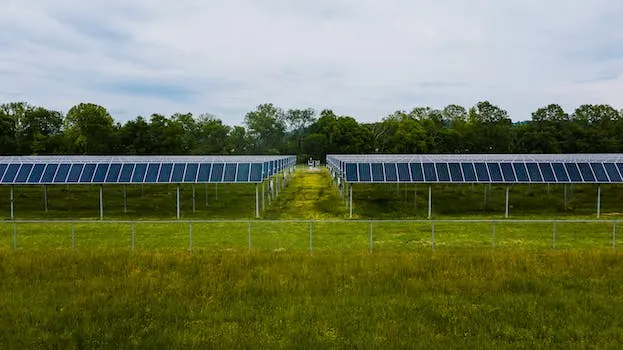
Harnessing the Power of Tides: How Tidal Power Can Transform Renewable Energy
Tidal power is a renewable energy source that has the potential to revolutionize the way we generate electricity. Through the use of turbines and barrages, this form of energy can be captured from the natural ebb and flow of ocean tides – providing a reliable source of clean energy with minimal environmental impact. Turbines are placed inside barrages, which are dams that utilize the potential energy generated by changes in height between high and low tides. This two-way system generates electricity from both incoming and outgoing tides, making it an efficient form of renewable energy production.
Tidal power requires no natural resources for production, installation or maintenance other than those used to build turbines and barrages. Despite its promise as a renewable energy source, tidal power does have some drawbacks such as limited suitable locations for installation due to geographical constraints as well as technological challenges associated with harnessing this type of power. Additionally, production costs can be higher than other forms of renewable energies such as solar or wind power.
In this article we will explore how tidal power works and how it can be used to provide clean energy for a wide range of applications. We will also discuss some potential solutions to address these challenges so that tidal power can become an even more viable option in our quest for sustainable sources of renewable energy in the future.
What is Tidal Power?
Tidal power is a method of harnessing the energy of the oceans’ tides to generate electricity. It works by using turbines or barrages to capture the energy produced by the rise and fall of the tide. The energy created by these tides is then converted into electricity and used to power homes and businesses. Tidal power is an inexhaustible source of renewable energy, as it relies on the gravitational pull of both sun and moon, meaning it will never run out. Additionally, tidal power does not emit any pollutants or greenhouse gases, making it a clean source of energy.
Tidal turbines are used to capture this Tidal energy in order to generate electricity. These turbines are more expensive than wind turbines but can capture more energy with smaller blades due to their proximity to water currents. Tidal turbines are raised out of water for servicing or installation purposes so that they can be maintained without disruption from ocean waves or currents.
Tides are caused by gravitational interaction between Earth, sun, and moon which creates a natural rise and fall in ocean waters twice daily - this movement can be harnessed as a form of renewable power known as tidal energy or tidal power. During the 20th century engineers developed ways to use this movement for generating electricity through various methods such as barrages which use dams across estuaries with large tide ranges; these barrages create reservoirs behind them which fill up during high tide before releasing water through hydroelectric generators during low tide when there is less resistance from incoming waves - thus creating an efficient cycle for producing electrical current from oceanic movements without disrupting marine life habitats in any way!
Advantages of Tidal Power
Tidal power is a reliable and cost-effective renewable energy source that has minimal environmental impact. Its predictability makes it a reliable source of energy for homes and businesses, as the tides can be predicted years in advance. Additionally, tidal power is flexible and can be used to generate electricity, desalinate water, or pump water for irrigation. It also has a higher energy density than other renewable sources such as wind or solar power. Furthermore, tidal power has low operational and maintenance costs compared to other forms of renewable energy. Finally, it is an inexhaustible source of clean energy that does not release any pollutants into the air when generated.
Tidal power offers many advantages over other forms of renewable energy sources due to its reliability and cost-effectiveness. The predictability of tides makes it an ideal choice for homes and businesses looking for a reliable source of energy that can be predicted years in advance with accuracy. Additionally, tidal power is highly flexible; it can be used to generate electricity, desalinate water or pump water for irrigation purposes with ease. Moreover, its high energy density means more efficient use of resources when compared to wind or solar power which are intermittent in nature and less predictable in terms of output levels.
The environmental benefits associated with tidal power are also noteworthy; since no pollutants are released into the atmosphere during generation unlike burning fossil fuels which produce greenhouse gases – making this form of renewable energy particularly attractive from an ecological standpoint too! Furthermore, operational costs associated with generating this form of clean electricity are relatively low compared to other forms such as wind or solar – making it even more attractive from an economic perspective too! Finally – unlike finite resources like fossil fuels – tidal waves will never run out meaning we have access to an inexhaustible supply if we choose wisely how we harness this natural resource!
How Does Tidal Power Work?
Tidal power is a renewable energy source that harnesses the natural rise and fall of ocean tides and currents to generate electricity. This energy can be captured using two main methods: turbines and barrages. tidal turbines are similar to wind turbines in that they have blades that turn a rotor to power a generator. They can be placed on the sea floor or in shallow waters, where they capture the kinetic energy of the tide as it passes by. Barrages are a type of dam which use the difference in water levels between high and low tide to generate electricity. The barrage is built across an estuary or bay, with turbines inside enabling it to fill during incoming tides and release through the system during outgoing tides, generating electricity in both directions. Another method for capturing tidal energy is called Tidal Stream Generator, which directly converts wave kinetic energy into mechanical power in turbine then into electrical energy. All these methods enable us to capture this powerful form of renewable energy from our oceans, transforming it into useful forms of power such as electricity for our homes and businesses.
Applications of Tidal Power
Tidal power is a renewable energy source that can be used in a variety of applications. It can be used to generate electricity for homes and businesses, reducing dependence on traditional energy sources and helping to lower electricity bills. Tidal power can also be used to pump water for irrigation and desalination, which helps reduce water scarcity in areas prone to drought or lack access to clean water. To harness tidal power, turbines must be more durable than wind turbines in order to withstand ocean currents, while tidal barrage projects require millions of dollars for construction.
Tidal energy is produced by the gravitational interaction between Earth, the sun, and the moon which causes the natural rise and fall of tides. This surge of ocean waters produces potential or kinetic energy that can then be converted into other forms of energy such as electricity or pressurized seawater without generating electricity for reverse-osmosis systems. The increased interest in renewable sources of sustainable energy has made tidal power an attractive option due its ability to provide reliable electricity with minimal environmental impact compared with other forms of renewable energies such as solar and wind power. Additionally, it offers an efficient way to produce pressurized seawater without generating additional electricity which could help reduce costs associated with desalination processes.
Overall, tidal power provides a reliable source of renewable energy that has many applications from powering homes and businesses to pumping water for irrigation and desalination purposes while also having minimal environmental impact compared with other forms of renewable energies such as solar or wind power. Although it requires more durable turbines than those used in wind turbines due its exposure to ocean currents as well as costly construction projects like barrages; these investments are worth it considering its potential benefits both economically through reduced dependence on traditional sources as well as environmentally through reduced emissions from burning fossil fuels.
Conclusion
The conclusion of our exploration into the potential of tidal power is clear: it is a renewable energy source with the potential to revolutionize the way we generate electricity. By harnessing the power of tides, we can reduce our dependence on traditional energy sources and create a more sustainable future. Tidal energy requires no natural resources, except for producing, installing, and maintaining turbines. It can be used in a variety of applications from powering homes and businesses to pumping water for irrigation and desalination. Through technologies such as Tidal barrages, fences and turbines, we can capture potential or kinetic energy from both incoming and outgoing tides – providing us with an abundant source of clean energy with minimal environmental impact. With further research into this technology, tidal power could become an integral part of our renewable energy portfolio in years to come.









